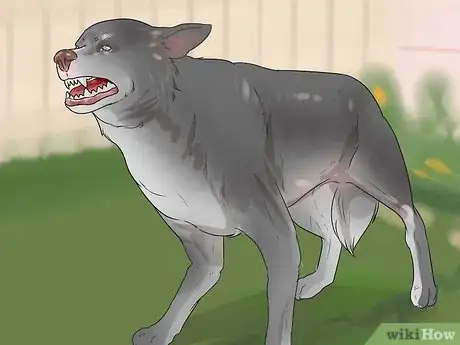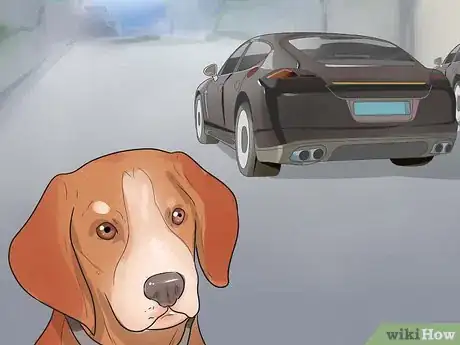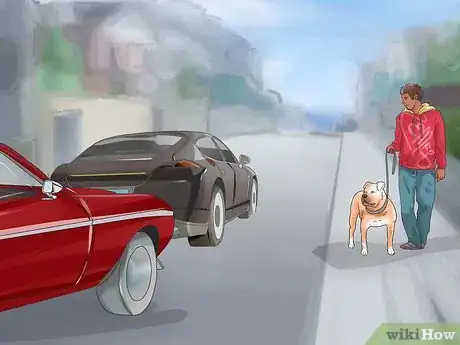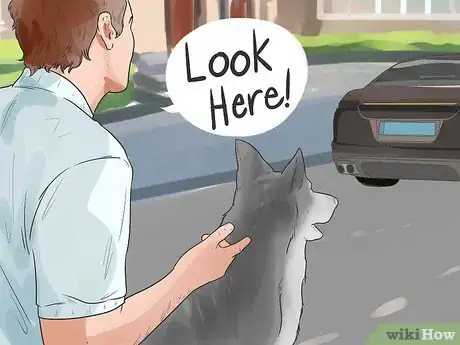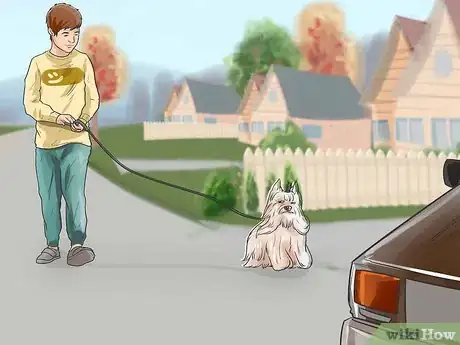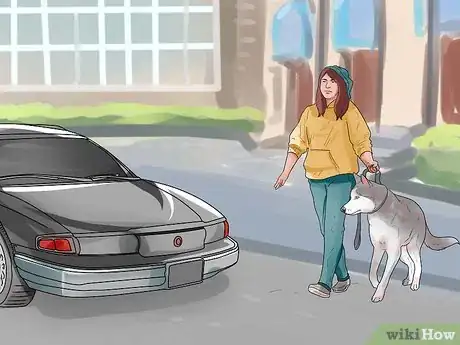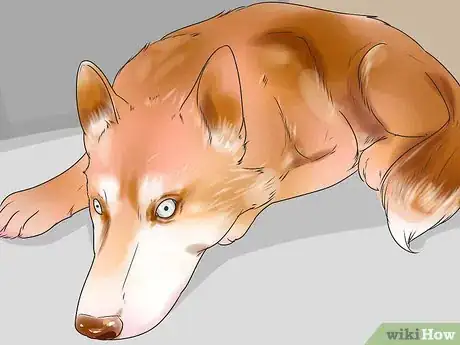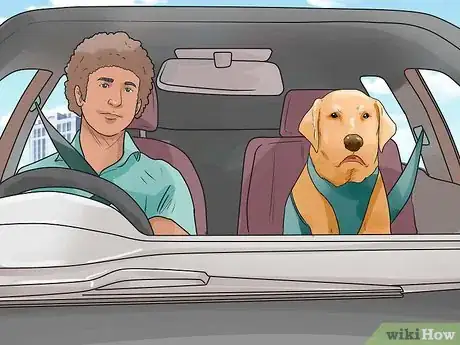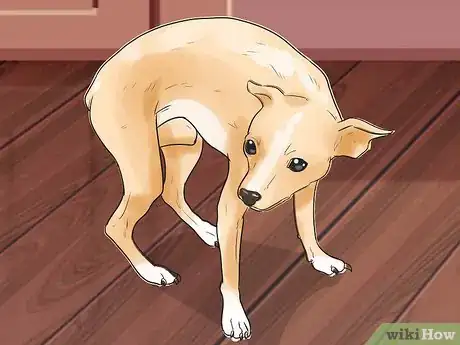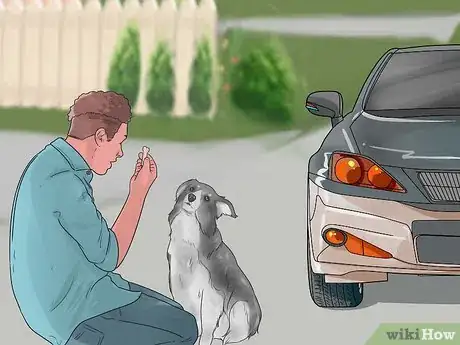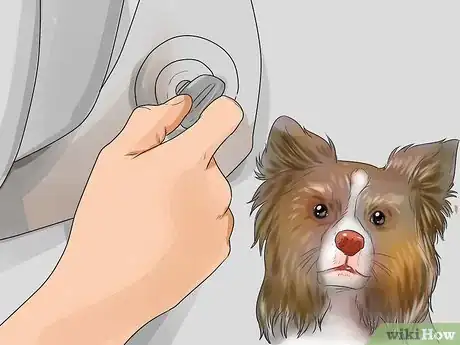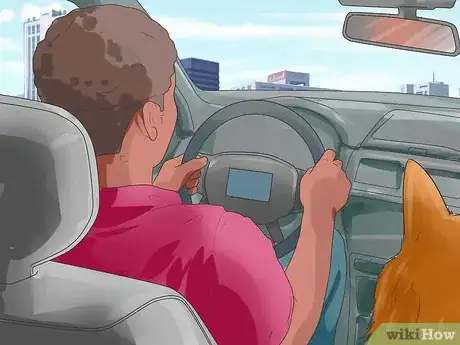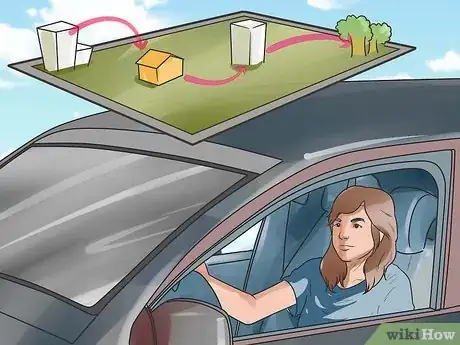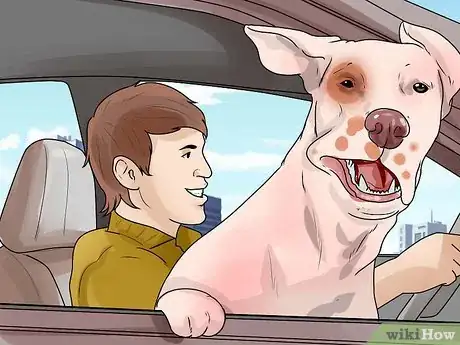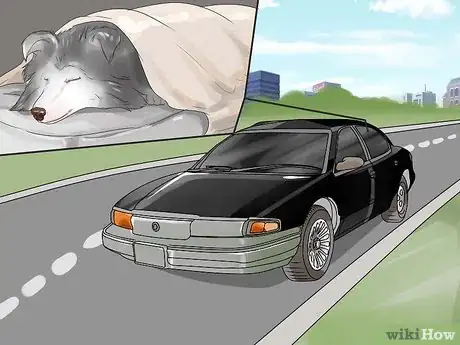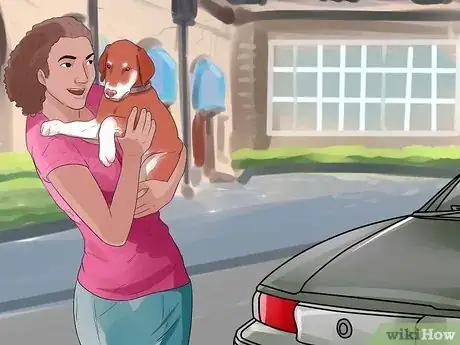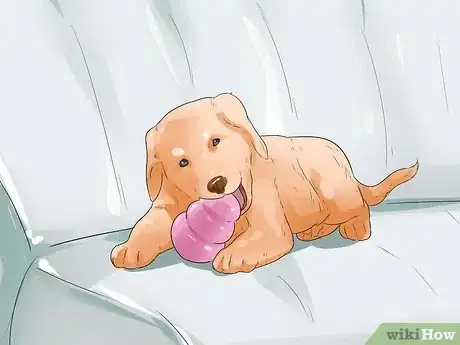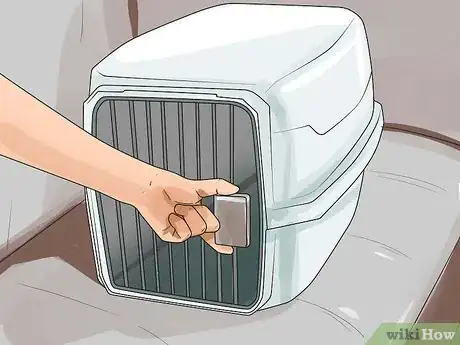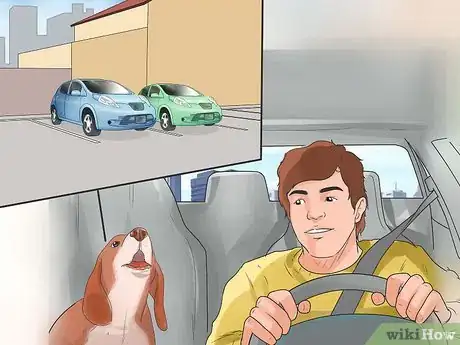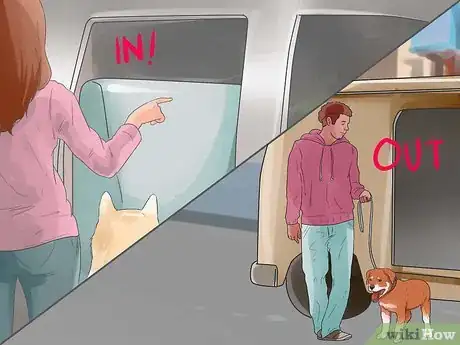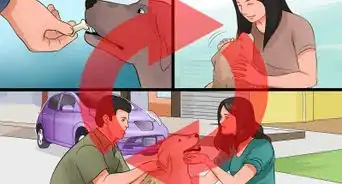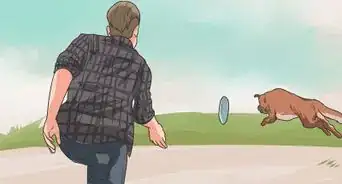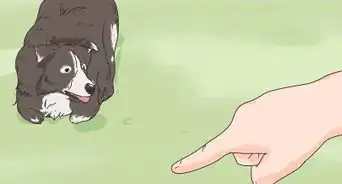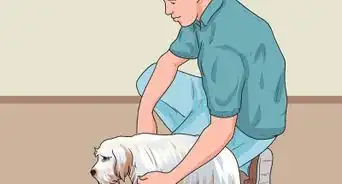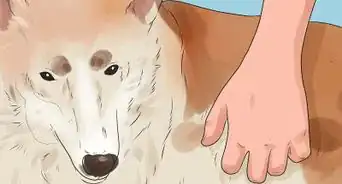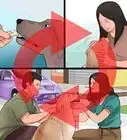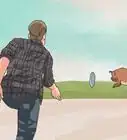This article was co-authored by Elisabeth Weiss. Elisabeth Weiss is a Professional Dog Trainer and owner of Dog Relations NYC, a dog training service in New York, New York. Elisabeth relies on science-based, force-free, and reward-based techniques. Elisabeth offers behavior training, puppy manners, body awareness and injury prevention, diet, exercise and dog nutrition services. Her work has been featured in New York Magazine and on the Dog Save the People podcast. She also trained all the dogs in the movie "Heart of a Dog" by Laurie Anderson that features Elisabeth's journey with Laurie Anderson's and Lou Reed's dog Lolabelle and how her passion for playing the keyboards played a significant role in improving her quality of life after being diagnosed with pancreatic cancer.
There are 12 references cited in this article, which can be found at the bottom of the page.
This article has been viewed 143,975 times.
If your dog is afraid of riding in the car or gets scared when cars pass by, car trips and walks along the street have probably been overwhelming for the both of you. The good news is that your dog’s fear of cars isn’t set in stone, and there are things you can do that will really help your furry friend feel more comfortable in and around vehicles. This wikiHow will walk you through how to help your dog overcome their fear of passing cars and/or riding in cars so you can both start enjoying your trips and walks together!
Steps
Overcoming Fear of Passing Cars
-
1Stay calm and cheerful. If you tense up every time a car passes, afraid of your dog’s reaction, your dog will notice. Your anxiety will reinforce their own. Instead, use a cheerful tone of voice and smile as you deal with passing traffic.
- Do not pet and soothe your anxious dog. Petting is a reward, so petting them when they are anxious will only reinforce the behavior.
- Do not scold or physically punish your dog for being afraid. Yelling at them will only intensify their fear.[1]
- Do not try to “cure” your dog by making them confront their fear. This will only increase their fear, not remove it.[2]
-
2Know the signs of fear and of relaxation in your dog. Your dog might bark or lunge at the end of the leash when a car passes, but this is only an extreme display of anxiety. To train them, you’ll need to know when they are even mildly anxious, so you can go slow, and when they are relaxed, so you can move on to the next step.Advertisement
-
3Let your dog hear traffic noises at home. Start by opening the windows when you are playing with your dog or feeding them, so that they can start to associate the noise of cars with pleasurable activities.[5]
-
4Expose your dog to cars at a distance. Once or twice a day, take your dog to a place in a park or a part of your yard that is far enough away from the street that your dog shows no fearful reaction when a car passes.
- Reward your dog with treats every time a car passes and praise them for staying calm.
- Do this for about a minute, then go inside or walk around the park for a couple of minutes before returning to the traffic for another minute.
- In all, expose your dog to traffic for a minute at a time, 5 or 6 times per training session.
- For the next session, increase the time your dog is exposed to traffic to 1.5 minutes. Continue gradually increasing the time from session to session.[6]
-
5Add a command. Giving your dog something to do can help to distract them from passing cars. As you gradually move closer to traffic, start giving a command like “touch” or “look here” whenever you see a car coming. Give your dog a treat when they obeys.
- If your dog is not able to focus on you or obey your commands because of traffic, take a break, move further from the traffic, and try again.
-
6Wait until your dog shows no sign of fear at each stage before moving closer. Sometimes it might take 2 or 3 weeks of training before your dog relaxes at a given distance. Other times it might happen in days. Always wait until your dog is relaxed and calm before moving closer.
-
7Walk your dog near traffic. Once your dog can deal with near-by passing cars while standing still, it’s time to start practicing while walking. However, if the dog shows signs of fear, do not force them to continue, as this will only heighten and reinforce their anxiety. Bring plenty of treats, and just as you did while stationary, have your dog perform a command whenever you see a car coming. Give your dog a treat when they obey.
-
8Train your dog to walk a particular route. For extremely fearful dogs, it is often best to start with one particular route where they feel safe. If your dog is still having trouble walking near cars, consider conditioning them to walk a particular route – such as the path to your local park.[7]
- Teach your dog to walk home first. Drive a quarter block from home along the path you will take, get out and walk home. If your dog pulls out of fear, stop and wait for them to stop pulling before you start again. Moving towards “safety” is their reward for good behavior. Be sure to keep distracting and treating your dog whenever cars pass.
- Each day, drive a quarter of a block further away along the path until you are driving them to the park and walking them home. Spend 1-2 weeks walking your dog home from the park.
- Next, teach your dog to walk to the park. Start by parking a quarter block from the park, walk them there, play, and then walk home.
- Continue adding a quarter block to your walk to the park each day until you are leaving from your home, walking to the park, and walking home.
Overcoming Fear of Car Travel
-
1Check for travel sickness before assuming your dog is afraid of the car for any other reasons. If not addressed, a simple case of motion sickness can be compounded by anxiety brought on by associating the car with sickness. See your vet for advice about medication that can alleviate the motion sickness.[8] Some symptoms of motion sickness include:[9]
- Whining and pacing
- Excessive drooling
- Lethargy
- Vomiting
- Diarrhea
-
2Make your car comfortable for your dog. Creating an environment that is comfortable and enjoyable for your dog will make overcoming their fears much easier and in some cases, may solve your dog’s dislike of the car.[10]
- Ensure that their harness fits properly or that their crate is the right size.
- Provide a blanket or toy that is special for your dog to help reassure them and to give them something to concentrate on.
- Ensure adequate air flow and a cool temperature. Never leave your dog in a car with the windows closed because the car will overheat and can kill your dog.
- Get rid of air fresheners. Any overwhelming smell in a car can be too much for your dog’s sensitive nose. Also avoid wearing too much perfume in the car.
-
3Watch for signs of fear and of relaxation in your dog. To train them, you’ll need to know when they are uncomfortable, so you can back off, and when they are relaxed, so you can move on to the next step.
-
4Do not take your dog on car trips if they are afraid. Trips in the car will only reinforce their fear, so avoid them, save for emergencies, until you've overcome their fear through desensitization (making them less sensitive to the experience) and counterconditioning (creating pleasant associations with the car to replace the negative ones).[13]
-
5Start by teaching your dog to approach the car without fear. When you go for a walk, give your dog a treat as you pass near the car. Play games like fetch or tug-of-war near the car. Feed your dog near the car, starting further away and moving the bowl progressively closer. When your dog shows no anxiety while eating or walking near your car, you are ready for the next step.[14]
- Start by approaching the car until the dog stops. Then, as a reward, move the dog away from the car, then give them a treat—preferably meat. At each session, encourage the dog to move a little closer to the car and see if you can make progress that way.[15]
-
6Train your dog to spend time in the car while it is not moving. You may need to lure your dog into the car with treats at first. While they are in the car continue to give treats or give them a chew bone or treat filled KONG. Leave the door open, and take these treats away when your dog leaves the car. Practice this once or twice a day for a week or two.[16]
- If the engine starting frightens your dog, try turning the car on before they get in. You can attempt to desensitize them, or simply continue starting the car before putting your dog in it.
- When your dog is comfortable in the car, start closing the door.
- As your dog’s comfort increases, try feeding them in the car.
-
7Turn the ignition on. Once your dog is comfortable in the car, try starting it with the dog in it. If your dog shows anxiety, then you might want to desensitize them. Start by starting the car with your dog nearby, but not in it. Have someone give treats as the car starts. Once your dog is comfortable, move them into the car and repeat the process.[17]
-
8Move the car a few feet and back. Drive your car down the driveway or a few feet down the street. Stop and with the engine running give your dog some treats or have a quick play session. Move back to your parking spot and end the session. Continue this until your dog is totally relaxed during these sessions.[18]
-
9Take short, fun trips. You want to make your dog’s first training drives in the car short, with a fun destination – preferably a park or hiking trail your dog enjoys. If there is one within a block or two, head there. If not, get in your car without your dog and drive it to within one or two blocks of your destination. Then, walk your dog to the car and drive the short remaining distance. Afterwards, walk your dog home.[19]
- Continue until your dog is comfortable with this short trip.
- Park further and further away as your dog grows comfortable in the car.
-
10Add more fun destinations. You want your dog to see the car not as a place of fear, but as a place of treats leading to wonderful destinations. Once your dog can handle short trips, try gradually longer ones to places they love like friend’s houses, pet stores, or other parks.
-
11Drive on the highway. Uninterrupted motion makes dogs sleepy and will help your dog to relax in the car. The highway is a great way to get your dog accustomed to longer trips in a relaxed manner.[20]
Introducing Your Puppy to Car Travel
-
1Familiarize your puppy with the vehicle as early as possible. A puppy under three months will be easier to train to get used to a vehicle than an older dog. The best way to overcome fear of your car is to avoid it in the first place with early training.[21]
-
2Teach your puppy that the car is a fun place. Before you take any trips with your puppy, introduce them to the car so that he can grow accustomed to it. Especially in the summer, make sure the car is running so you can keep it cool. This will also help your dog grow accustomed to the sound of the motor. To help your puppy get comfortable:[22]
- Place a bed on the seat so your dog is comfortable and doesn’t slip on the upholstery.
- Feed you your puppy meals in the car.
- Give your dogs treats, such as a stuffed KONG or bone to chew on.
-
3Get your puppy accustomed to being restrained in either a crate or under a harness for travel. Always travel with your dog restrained for his safety. When introducing your dog to the car, it is important that they wear the same restraint they will when traveling, or go in a carrier if that is how you will transport them.
- If using a harness, you can practice putting it on in your home before trying it in the car. Give your dog lots of treats when you put it on, then take it off. Gradually increase the amount of time they wear it, eventually giving them a bone or chew toy to play with while in the harness.
- If using a crate, you should crate train your dog before trying the crate in the car.
-
4Start with short rides. Dogs often suffer from motion sickness during their first few car rides, so you’ll want to keep your puppy's first trips short. Start with just going in and out of the driveway and gradually build up to more.[23]
- For the first 2-3 days, just back out of the driveway or drive a few feet down the street, then return to you parking place. Do this once or twice a day.
- Next, try driving around the block for a couple of days.
- Move on to a five minute drive. As long as your dog shows no signs of anxiety – panting, trembling, whining, cowering, or drooling – you can slowly increase the lengthy of trips over several weeks.
-
5Take your dog to places they like. If you only use the car to take your dog to the vet, your dog is not going to like the car. Especially when you dog is a puppy, try to have most car trips end somewhere fun, like the park, the hiking trail, a pet store, a friend’s house, or a dog park. If your dog is anticipating the destination, they won’t mind the drive so much.[24]
-
6Have your dog get in and out of the car by themselves as soon as they can. Especially for bigger breeds, teaching your dog to get in and out on their own will save you a lot of back pain when they is full grown.
- Getting In – Pick a command word like “in” for entering the car. If necessary, use treats to lure your dog into the car at first. Be sure to use the command word as your dog enters, so they starts to associate the word with the action.
- Getting Out – Pick a command word like “out”. It is very important to teach you dog to wait to leave the car until asked. Teach your dog “wait” at home. Have your dog wait in the car, then get out on command. Practice with a leash on at first, to be sure your dog won’t run off.
Expert Q&A
Did you know you can get expert answers for this article?
Unlock expert answers by supporting wikiHow
-
QuestionMy five-month-old Labrador won't go near the car even when I bribe him with treats. What do I do?
 Pippa Elliott, MRCVSDr. Elliott, BVMS, MRCVS is a veterinarian with over 30 years of experience in veterinary surgery and companion animal practice. She graduated from the University of Glasgow in 1987 with a degree in veterinary medicine and surgery. She has worked at the same animal clinic in her hometown for over 20 years.
Pippa Elliott, MRCVSDr. Elliott, BVMS, MRCVS is a veterinarian with over 30 years of experience in veterinary surgery and companion animal practice. She graduated from the University of Glasgow in 1987 with a degree in veterinary medicine and surgery. She has worked at the same animal clinic in her hometown for over 20 years.
Veterinarian Don't pressure the pup. Make sure the car is stationary with the engine turned off. Figure out how close he is happy to approach, and fuss and praise him. Then take a treat or toy and entice him one step closer. Praise and pet him, and finish for that session. The next session, start at the same spot, tell him how clever he is, then advance another step, praise and pet. The idea is to literally take it a step at a time until he is comfortable approaching the car.
Don't pressure the pup. Make sure the car is stationary with the engine turned off. Figure out how close he is happy to approach, and fuss and praise him. Then take a treat or toy and entice him one step closer. Praise and pet him, and finish for that session. The next session, start at the same spot, tell him how clever he is, then advance another step, praise and pet. The idea is to literally take it a step at a time until he is comfortable approaching the car. -
QuestionHow can I help my dog be less afraid of riding in the car?
 Elisabeth WeissElisabeth Weiss is a Professional Dog Trainer and owner of Dog Relations NYC, a dog training service in New York, New York. Elisabeth relies on science-based, force-free, and reward-based techniques. Elisabeth offers behavior training, puppy manners, body awareness and injury prevention, diet, exercise and dog nutrition services. Her work has been featured in New York Magazine and on the Dog Save the People podcast. She also trained all the dogs in the movie "Heart of a Dog" by Laurie Anderson that features Elisabeth's journey with Laurie Anderson's and Lou Reed's dog Lolabelle and how her passion for playing the keyboards played a significant role in improving her quality of life after being diagnosed with pancreatic cancer.
Elisabeth WeissElisabeth Weiss is a Professional Dog Trainer and owner of Dog Relations NYC, a dog training service in New York, New York. Elisabeth relies on science-based, force-free, and reward-based techniques. Elisabeth offers behavior training, puppy manners, body awareness and injury prevention, diet, exercise and dog nutrition services. Her work has been featured in New York Magazine and on the Dog Save the People podcast. She also trained all the dogs in the movie "Heart of a Dog" by Laurie Anderson that features Elisabeth's journey with Laurie Anderson's and Lou Reed's dog Lolabelle and how her passion for playing the keyboards played a significant role in improving her quality of life after being diagnosed with pancreatic cancer.
Professional Dog Trainer Approach the car with the dog, and when it stops, reward it by allowing it to get more distance from the car. Then, feed them a high-value treat—usually meat is best. Then, see if you can get a little closer to the car at the next session. Then, hopefully they'll begin to associate the car with the treat instead of fear.
Approach the car with the dog, and when it stops, reward it by allowing it to get more distance from the car. Then, feed them a high-value treat—usually meat is best. Then, see if you can get a little closer to the car at the next session. Then, hopefully they'll begin to associate the car with the treat instead of fear. -
QuestionHow do I stop my dog from barking at every car and throwing himself across his cage?
 Community AnswerOur dog did this too. Try putting him in a crate or carrier in the car with his favorite toy in a position where he cannot see the traffic. Cover the crate with a blanket if necessary. Talk to him in a soothing voice so he knows you're still there.
Community AnswerOur dog did this too. Try putting him in a crate or carrier in the car with his favorite toy in a position where he cannot see the traffic. Cover the crate with a blanket if necessary. Talk to him in a soothing voice so he knows you're still there.
Warnings
- If you need to take your dog on a long trip before your dog’s car training is complete, talk to your vet about sedating them. Otherwise, the trip might erase all the work you have done.[26]⧼thumbs_response⧽
- Never let your dog ride in the front seat of a car unless they are wearing a harness and the air bag has been deactivated. Deployed air bags can kill dogs.[27]⧼thumbs_response⧽
References
- ↑ https://www.aspca.org/pet-care/virtual-pet-behaviorist/dog-behavior/fear-noises
- ↑ https://www.aspca.org/pet-care/virtual-pet-behaviorist/dog-behavior/fear-noises
- ↑ https://www.aspca.org/pet-care/virtual-pet-behaviorist/dog-behavior/fear-riding-cars
- ↑ https://www.aspca.org/pet-care/virtual-pet-behaviorist/dog-behavior/fear-riding-cars
- ↑ https://www.aspca.org/pet-care/virtual-pet-behaviorist/dog-behavior/fear-noises
- ↑ https://www.aspca.org/pet-care/virtual-pet-behaviorist/dog-behavior/fear-noises
- ↑ https://www.aspca.org/pet-care/virtual-pet-behaviorist/dog-behavior/fear-noises
- ↑ Sarah Whitehead, The City Dog: The Essential Guide for the Urban Owner, p. 99, (2008), ISBN 978-0-600-61724-2
- ↑ http://www.vcahospitals.com/main/pet-health-information/article/animal-health/motion-sickness-in-dogs/6541
- ↑ http://www.vetstreet.com/our-pet-experts/help-my-dog-hates-riding-in-the-car-what-can-i-do
- ↑ https://www.aspca.org/pet-care/virtual-pet-behaviorist/dog-behavior/fear-riding-cars
- ↑ https://www.aspca.org/pet-care/virtual-pet-behaviorist/dog-behavior/fear-riding-cars
- ↑ https://www.aspca.org/pet-care/virtual-pet-behaviorist/dog-behavior/fear-riding-cars
- ↑ Dr. Nicholas H. Dodman, The Well-Adjusted Dog, p. 132, (2008), ISBN 978-0-618-83378-8
- ↑ Elisabeth Weiss. Professional Dog Trainer. Expert Interview. 3 September 2020.
- ↑ https://www.aspca.org/pet-care/virtual-pet-behaviorist/dog-behavior/fear-riding-cars
- ↑ Dr. Nicholas H. Dodman, The Well-Adjusted Dog, p. 124, (2008), ISBN 978-0-618-83378-8
- ↑ https://www.aspca.org/pet-care/virtual-pet-behaviorist/dog-behavior/fear-riding-cars
- ↑ https://www.aspca.org/pet-care/virtual-pet-behaviorist/dog-behavior/fear-riding-cars
- ↑ https://www.aspca.org/pet-care/virtual-pet-behaviorist/dog-behavior/fear-riding-cars
- ↑ Sarah Whitehead, The City Dog: The Essential Guide for the Urban Owner, pp. 96-97, (2008), ISBN 978-0-600-61724-2
- ↑ https://www.aspca.org/pet-care/virtual-pet-behaviorist/dog-behavior/fear-riding-cars
- ↑ https://www.aspca.org/pet-care/virtual-pet-behaviorist/dog-behavior/fear-riding-cars
- ↑ https://www.aspca.org/pet-care/virtual-pet-behaviorist/dog-behavior/fear-riding-cars
- ↑ Dr. Nicholas H. Dodman, The Well-Adjusted Dog, pp. 130 and 132-133, (2008), ISBN 978-0-618-83378-8
- ↑ https://www.aspca.org/pet-care/virtual-pet-behaviorist/dog-behavior/fear-riding-cars
- ↑ https://www.aspca.org/pet-care/virtual-pet-behaviorist/dog-behavior/fear-riding-cars
About This Article
To deal with your dog's fear of traveling in vehicles, watch for symptoms of motion sickness, which you can easily treat with medication. Next, take walks and play with your dog near the vehicle to minimize its fear of approaching it. Then, spend a few minutes 1-2 times per week with your dog inside a parked car. Give your dog treats and praise during these training sessions so it creates positive associations with vehicles. For more advice from our Veterinary co-author, like how to help a dog that's afraid of passing cars, read on!

